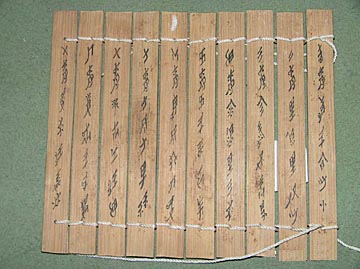Women's Script
Updated: 2007-08-29 08:50

Nushu (women's script) is composed of very strange characters, which feature strange shapes, a strange way of marking, strange social functions and history.
Nushu was popular in the valley of the Xiaoshui River in Jiangyong County of Hunan Province, and is still used by some senile women nowadays. There are several local sayings about the origin of this women's script.
One saying has it that since ancient times, women in the valley of the Xiaoshui River in Jiangyong County have liked to gather together for embroidery and weaving. They could not afford schooling to learn men's script (they called the square Chinese characters as men's script). In order to record their hard life, they jointly created the women's script based on the patterns they wove and embroidered.
Nushu was derived from square Chinese characters, and were variations of the later. Researches show that Nushu had more than 1,000 characters, among which 80% were created based on Chinese characters, and only 20% were coinages with unknown origin. Its characters took the shape of rhombus, and were higher on the right part and lower on the left part. They are slender and beautiful, look like Jiaguwen (scripts on tortoise shells and animal bones) at first glance, and retain much familiar trace of Chinese characters.
The investigations and researches done by linguists these years show the way of recording Nushu is not the Hunan dialect, Southwest official language or the dialect of the Yao nationality, but a local dialect prevalent along the Jiangyong area. Different from Chinese ideographic characters, Nüshu characters are ideographic characters that have a single syllable and indicate their sound.
Nushu was the tool of cultural communication for local countryside women, especially middle- and old-aged women. It played its unique social function, and was basically used to create women's works and record women's songs. The songs it recorded were generally composed of seven-character lines. The longest ones of their works had four to five thousand characters, and the shortest ones only had dozens of characters. Nushu works normally were written on delicately made manuscripts, fans, handkerchiefs and pieces of paper.
Nushu has academic value from the perspectives of philology, linguistics, sociology, ethnography, and history, etc. Therefore, it is reputed as a wonderful discovery and a wonder in the history of Chinese characters by scholars home and abroad.